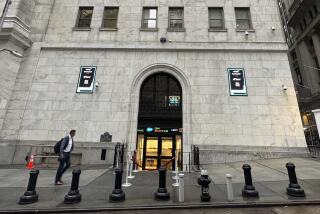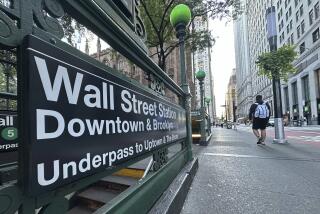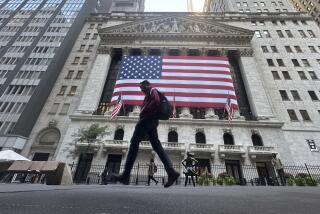Dow Up Record 44.01, Closes at a New High
NEW YORK â Fueled by the billions of dollars in cash that investors had raised in tax-related year-end stock sales, the Dow Jones industrial average on Monday made its largest one-day point gain in history, surging 44.01 points to a record close of 1,971.32.
The gain surpassed the previous one-day record of 43.41, set on Nov. 3, 1982, when the index of 30 blue-chip stocks closed at 1,065.49. But in percentage terms, Mondayâs advance was only about one-half of the magnitude of the previous record. Still, the Dow industrials gained more than 75 points, or 4%, in the first two trading days of 1987, after weakening consistently through most of December.
âThe action in the last two sessions has really been a mirror-image of December, when there wasnât a buyer anywhere in the United States,â said Michael Metz, investment strategist for the brokerage firm of Oppenheimer & Co.
The breadth of Mondayâs rally bodes well for the marketâs overall strength, he added. âAlmost every cat and dog, as well as the blue chips, are participating,â he said.
There were 1,602 stocks gaining in price Monday on the New York Stock Exchange and only 165 declining. At the same time, 87 issues reached new highs compared to only four reaching new lows, a ratio followed by analysts, who contend that such a broad advance is an essential feature of a bull market. Trading volume on the exchange picked up appreciably from Fridayâs holiday pace, with 181.35 million shares traded, compared to 91.88 million on Jan. 2.
Mondayâs close exceeded the Dowâs earlier peak of 1,955.57, which was set Dec. 2. Broader market indicators also were sharply higher, although none reached new highs. The New York Stock Exchange Composite Index had its largest one-day gain in history, rising 3.38 points, to close at 144.39.
The marketâs activity set some Wall Street professionals to predicting that the Dow industrials would soon surpass 2,000 points, possibly within the next few weeks. After that, many economists and analysts expect the market to fall back for some time before surging to 2,500, or higher.
âFlip of Calendar Pageâ
Many of them acknowledged that the fledgling 1987 rally is largely a product of the determined selling of late 1986. âItâs very much related to the flip of the calendar page,â said Eugene D. Peroni, technical analyst for the Philadelphia investment firm of Janney Montgomery Scott.
Although investors have often sold securities late in the year to benefit from capital-gains tax treatment, the tax-law change effective Jan. 1 this year magnified that trend.
The maximum tax bracket will drop sharply this year, to 38.5% from 50% of taxable income, meaning that wealthier investors had an incentive to take capital losses before Jan. 1 by selling unprofitable stocks. Because of the higher tax rates of 1986, those losses were worth more as tax deductions last year than now. Furthermore, the new tax code limits the amount of capital losses that can be deducted from income.
At the same time, changes in the capital-gains rules added an incentive to sell profitable stocks. Profits on stocks held for at least six months were taxed last year at a maximum of 20%; starting this year, all capital gains will be taxed at a maximum of 28%.
Few on Wall Street had gauged the magnitude of such year-end selling, although the fall of the Dow industrial index from its 1,955.57 peak on Dec. 2 to 1,895.95 on Dec. 31 suggested that portfolios were being actively cleaned out. Moreover, some of Mondayâs big gains were scored in stocks that had taken the brunt of portfolio clearance sales. On the New York Stock Exchange, these included IBM, which closed at $123.625, up $1.625; General Electric, which closed at $90.125, up $2.75; and Eastman Kodak, which closed at $71.25, up $2.
Cites Other Changes
âJust the cessation of selling (in the first two days of 1987) lifted the market,â said Ben Niedermeyer, portfolio manager at the Denver-based investment-management and mutual fund firm of Janus Capital. Niedermeyer also noted that one other aspect of the tax code generated excess cash for investment: Changes in the rules governing the sale of small or privately owned businesses encouraged entrepreneurs to cash out by year-end.
âWe have several clients who sold their businesses to generate gains in 1986,â he said. âWeâve seen a lot of cash come from that into our managed accounts and the mutual fund.â
Mondayâs activity was dominated, not unexpectedly, by institutional investors, including managers from pension and mutual funds. Many corporate pension funds are now beginning to invest cash provided by their corporate sponsors, as required at the beginning of each year.
Economic and political factors may also have played a role in the rally. Most economists have been predicting some 1987 growth, even if modest, in the U.S. economy. And encouraging news about President Reaganâs surgery soothed concerns about his health, which often have a minor depressing effect on the market.
Indexes Near Record Levels
Although no other major market indexes reached new highs Monday, several are close to their records, and the marketâs overall strength was notable. The New York Stock Exchange Composite Index close of 144.39 is just short of its record 145.75, and the Standard & Poorâs index of 500 favorite institutional stocks rose 5.74, to close at 252.19, also a bit short of its record of 254.0.
The American Stock Exchange index rose 4.58, to close at 272.07, well short of its peak of 285.19, and the NASDAQ Over-The-Counter composite rose 4.5, to close at 357.76, well below its peak of 411.16.
The wider divergences among the American and OTC indicators demonstrate that the current rally is still concentrated in âqualityâ stocks rather than the more speculative issues that affect those indexes. Some on Wall Street expect investors to turn more to the smaller stocks later this year as New York Stock Exchange issues become relatively more expensive.
More to Read
Inside the business of entertainment
The Wide Shot brings you news, analysis and insights on everything from streaming wars to production â and what it all means for the future.
You may occasionally receive promotional content from the Los Angeles Times.










